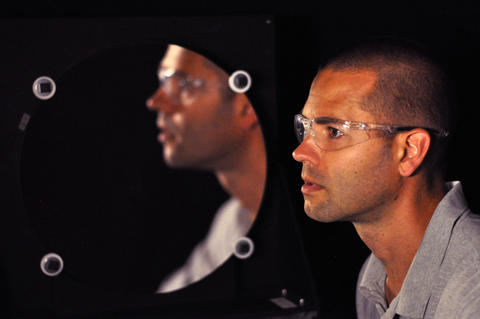Many people wear masks in public to slow the spread of COVID-19, as recommended by the Centers for Disease Control and Prevention (CDC). However, masks with exhalation valves do not slow the spread of the disease, and now, new videos from the National Institute of Standards and Technology (NIST) show why.
The videos, which show airflow patterns through masks with and without exhalation valves, were created by NIST research engineer Matthew Staymates. The videos were published, along with an accompanying research article, in the journal Physics of Fluids.
“When you compare the videos side by side, the difference is striking,” Staymates said. “These videos show how the valves allow air to leave the mask without filtering it, which defeats the purpose of the mask.”
“I don’t wear a mask to protect myself. I wear it to protect my neighbor, because I might be asymptomatic and spread the virus without even knowing it.” — Matthew Staymates, NIST research engineer
Exhalation valves, which make masks easier to breathe through and more comfortable, are appropriate when the mask is meant to protect the wearer. For instance, valved masks can protect workers from dust at a construction site or hospital workers from infected patients.
The masks that the CDC recommends for slowing the spread of COVID, however, are mainly meant to protect people other than the wearer. They slow the spread of the disease by capturing exhaled droplets that might contain the virus. Even people without symptoms should wear masks, according to the CDC, because it is possible to be infected but not show symptoms.

“I don’t wear a mask to protect myself. I wear it to protect my neighbor, because I might be asymptomatic and spread the virus without even knowing it,” Staymates said. “But if I’m wearing a mask with a valve on it, I’m not helping.”
Staymates is an expert in flow visualization techniques that allow him to capture the movement of air on camera. His usual research involves new technologies for detecting explosives and narcotics at airports and shipping facilities by sniffing out traces of those materials in the air. He recently turned his expertise toward masks to help develop new ways to measure and improve their performance.
Staymates created two videos using different flow visualization techniques. The first video (above) was created using what is known as a schlieren imaging system, which causes differences in air density to show up on camera as patterns of shadow and light.
With a schlieren imaging system, exhaled breath becomes visible because it is warmer, and therefore less dense, than the surrounding air. This video only shows the movement of air itself, not the movement of exhaled droplets in the air. On the left, Staymates is wearing an N95 respirator mask with a valve, which allows exhaled air to stream into the environment unfiltered. On the right, there is no valve, and the air passes through the mask, which filters out most of the droplets.
Staymates created the second video using a light-scattering technique.
For the second video, Staymates built an apparatus that emits air at the same velocity and tempo as a resting adult, then connected that device to a mannequin. As a stand-in for exhaled droplets, the air carries water droplets in a range of sizes typical of the droplets that people emit in their breath when exhaling, speaking and coughing. A high-intensity LED light behind the mannequin illuminates the airborne droplets, causing them to scatter the light and show up brightly on camera.
In contrast to the schlieren video, this video shows the movement of droplets in air. On the left, droplets escape unfiltered through the valve of an N95 mask. In the middle, there is no valve and no breath is visible because the mask has filtered out the droplets. On the right, no mask is worn.
The use of a mannequin and a mechanical breathing apparatus allowed Staymates to observe airflow patterns while holding steady the breathing rate, air pressure and other variables.
In addition, the videos produced by light scattering can be analyzed by a computer in a way that schlieren images cannot. Staymates wrote computer code that calculated the number of bright pixels in the video and used that to estimate how many droplets were in the air. This is not a true measure of the number of droplets because two-dimensional video cannot capture what’s happening in the full three-dimensional volume of air. However, the resulting numbers provide trends that can be analyzed to better understand the airflow dynamics of different types of masks.
This research project looked at only one type of valved mask; different types of valved masks will perform differently. Also, masks that are not tight-fitting will allow some air to escape around the mask rather than filtering through it. This can also compromise the filtering performance of the mask.
But the main effect of valves is visible in these videos. Staymates hopes the videos help people understand — at a glance — why masks meant to slow the spread of COVID-19 should not have valves.
Paper: M.E. Staymates. Flow visualization of an N95 respirator with and without an exhalation valve using schlieren imaging and light scattering. Physics of Fluids. Published online Nov. 10, 2020. DOI: 10.1063/5.0031996

